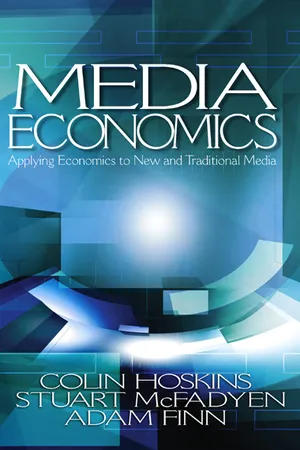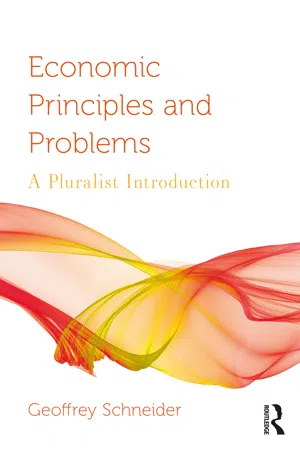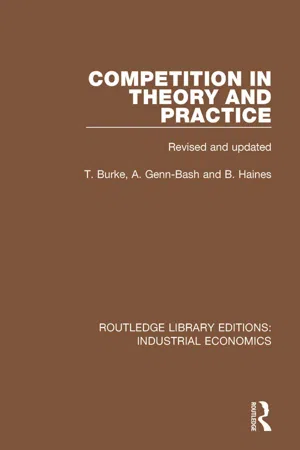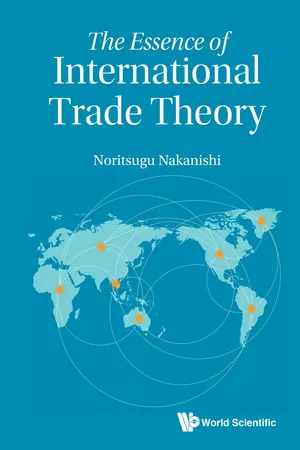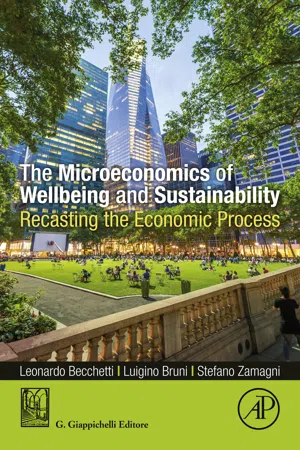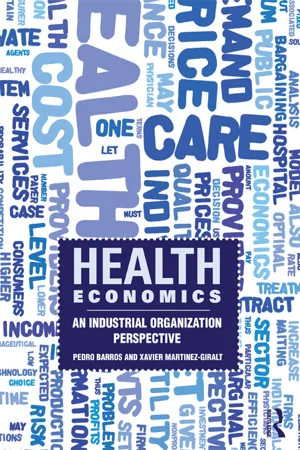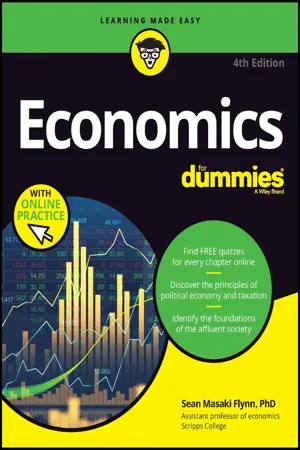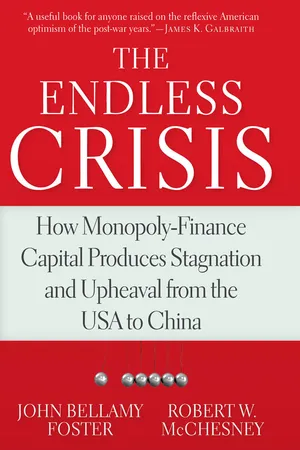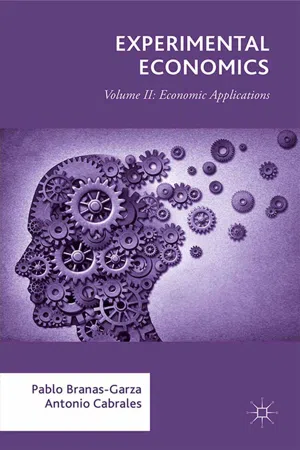Economics
Monopolistic Competition in the Short Run
Monopolistic competition in the short run refers to a market structure where many firms offer similar but slightly differentiated products. In this scenario, firms have some degree of market power, allowing them to set prices above marginal cost. However, entry and exit barriers are low, and firms can earn economic profits or losses in the short run due to product differentiation and advertising.
Written by Perlego with AI-assistance
Related key terms
Related key terms
1 of 4
Related key terms
1 of 3
12 Key excerpts on "Monopolistic Competition in the Short Run"
- eBook - ePub
Media Economics
Applying Economics to New and Traditional Media
- Colin Hoskins, Stuart M. McFadyen, Adam Finn(Authors)
- 2004(Publication Date)
- SAGE Publications, Inc(Publisher)
This market structure is similar to perfect competition, with free entry and exit and many small firms, but in monopolistic competition, the firms produce differentiated products. A monopolistic competitor thus has some control over price because no other firm makes an identical product. This price discretion is very limited, however, because there are many competitors producing close substitutes. A given customer may prefer the XYZ Video Store because of its location, selection, layout, or some other feature. The customer may stay loyal to the store if its nightly rental rate is $0.25 higher than some competitors, but not if it is $0.50 higher. The demand curve for the firm is thus negatively sloped.In monopolistic competition, as in perfect competition, each of the many small firms has such a small market share that a decrease in price by one company will have no significant effect on the sales of any other firm. Thus each monopolistic competitor will make its price decision in the belief that other firms will leave their prices unchanged. This differs from oligopoly, where other firms feel a need to follow the price decreases of a competitor to protect market share. (If you think that the video stores in the area you live in would react to the price cut of a competitor, then video stores in your market are not an example of monopolistic competition but of oligopoly.)Free entry and exit means that only zero economic profits can be earned in long-run equilibrium. 9.1.1 Short-Run Equilibrium Under Monopolistic CompetitionThe short-run equilibrium is the price and output at which MR = SMC. P0 and Q0 for a typical firm are shown in Figure 9.1 . In short-run equilibrium, the firm may make positive, zero, or negative economic profits. To illustrate this, three alternative average total cost curves are drawn under different assumptions about the level of fixed costs. If ATC1 applies, the typical firm enjoys positive economic profits, as AR > ATQ at the profit maximizing price and output. If ATC0 applies, zero economic profits are earned, as AR = ATC0 . If ATC2 applies, negative economic profits are earned, as AR < ATC2 . However, the firm will still produce output Q0 at price P0 , rather than shut down, as long as AR is greater than average variable cost (not shown in Figure 9.1 - eBook - ePub
Economic Principles and Problems
A Pluralist Introduction
- Geoffrey Schneider(Author)
- 2021(Publication Date)
- Routledge(Publisher)
Monopolistic competition is a market very similar to perfect competition, but there is one major difference: Firms in a monopolistically competitive market have a monopoly on one unique aspect of the market. This product differentiation allows some firms to charge higher prices than others, which is not possible in a perfectly competitive market.12.3 Monopolistic competition
Monopolistic competition is another very competitive market structure with a large number of small firms due to easy entry into the market. Unlike in perfect competition, firms have a monopoly over certain unique business characteristics such as quality, brand, or location. This gives firms some control over their prices. Firms supply goods that are close but not perfect substitutes for each other. Examples include local services such as doctors, dentists, and lawyers and local retailers such as restaurants, bars, and gas stations. Businesses in all of these industries offer a similar product, but some can charge a higher price than others due to the differences in quality, brand, and location.The major characteristics of a monopolistically competitive market are as follows:- Slightly differentiated products: Goods are close but not perfect substitutes for each other. If firms can successfully improve quality and establish brand name recognition, they can further differentiate their product from competing ones.
- Large number of sellers and buyers: The large number of competitors and consumers means that no one actor has a large influence over the market. Some firms are larger than others but no firm is dominant.
- Easy entry and exit
- eBook - ePub
The Economics of Small Business
An Introductory Survey
- Roger A McCain(Author)
- 2018(Publication Date)
- WSPC(Publisher)
Free entry means that new companies can set up in business to compete with established companies whenever the new competitors feel that the profits are high enough to justify the investment. This is, first and foremost, a legal condition. That is, in a “perfectly competitive” market there are no government restrictions on the entry of new competition. This legal status is often expressed by the French phrase “laissez faire,” meaning “let them make (whatever they want to make for sale).” But it could also be a practical condition. For example, if no one could set up in business without enormous capital investments, that might prove an effective limit on the entry of new competition — especially if, for some reason, the capital cannot be raised by borrowing or issuing shares.Other, more or less noncompetitive market structures are also defined in terms of these characteristics. The other three market structure models can be defined in terms of the ways in which they deviate from the characteristics of “perfect” competition.In a “monopoly,” there is just one seller of a good or service for which there is no close substitute. In an “oligopoly,” there are two or more but only a few sellers. In “monopolistic competition,” the products are not homogenous but are “differentiated.”At first thought, it might seem that these forms could only exist with “big business” — that they will not correspond to small business. However, since small businesses may exist in small local markets, any of the three, even monopoly, might in principle include some small businesses. However, of these three, monopolistic competition may be the most relevant for small business. The reason is that local markets are likely to overlap. Thus, we might say that for many small businesses, the product or service is differentiated by location. On the whole, the model of monopolistic competition with product or service differentiation by location seems the best general model for the economics of small business. In what follows, we will recall some of the basic ideas from the models of perfect and monopolistic competition in order to contrast them.1.1.Cost
For either sort of firm, cost is an important determinant of supply, so let us first review the analysis of cost in elementary economic theory. There are two dichotomies: fixed cost (FC) and variable cost (VC) (on the one hand) and money and implicit or opportunity cost (on the other.) By looking at the firm from the point of view of costs, we gain a much more direct understanding of supply. - eBook - ePub
- Terry Burke, Angela Genn-Bash, Brian Haines(Authors)
- 2018(Publication Date)
- Routledge(Publisher)
If public goods, such as defence, are provided at all in a free market economy they are likely to be provided at a suboptimal level. In addition to public goods, the existence of externalities are another reason why perfect competition may not achieve an optimal resource allocation. There is no guarantee that an optimal distribution of income will occur under perfect competition. Also diseconomies of scale must exist and indeed occur beyond a relatively small level of output. The efficient size of firm must be small enough for the industry to efficiently support a very large number of firms.However, empirical evidence on this latter point suggests that the long-run average cost curve does not turn upwards over feasible output levels in most industries. This implies that small firms have an incentive to expand their size and reap the benefits of lower unit costs. Also, economies of scale imply that the marginal cost curve will be below the average cost curve and the profit maximising rule of setting price equal to marginal cost under perfect competition will result in financial losses for the firm.These various problems associated with perfect competition resulted in the development of other theories of competitive behaviour, such as the theory of monopolistic competition which we will consider next.Monopolistic competitionThis theory was developed by Chamberlin (1933). It applies to market situations where a large number of firms are selling similar but differentiated products. Competition would not only apply to the price charged but also to the quality of the product, labelling, advertising and sales promotion. Hence non-price competition is important in such markets.As in perfect competition the assumption of free entry into and exit from the market still applies. Unlike perfect competition each good is slightly different in composition or brand image. For instance, different brands of toothpaste or detergents are similar but not identical to one another. As a result each firm does not face a perfectly elastic demand curve for its product and hence is not a price taker. The firm’s demand curve is downward sloping under conditions of monopolistic competition. One firm may charge a higher price than its rivals without losing all its customers due to brand loyalty for its product. Although supernormal profits are possible in the short run, because of the free entry assumption, only normal profits will be made in the long run. In other words, new firms would be attracted into the industry in the long run if short-run supernormal profits are being earned. The result of this new entry will be that each individual firm will be unable to operate at full capacity. Average costs of production will not be minimised and hence firms will be producing inefficiently. Figure 3.1 - eBook - ePub
- Noritsugu Nakanishi(Author)
- 2018(Publication Date)
- WSPC(Publisher)
Chapter 6Monopolistic Competition
We develop models incorporating monopolistic competition, which are characterized by the increasing-returns-to-scale technology and product differentiation. The monopolistically competitive models have been first introduced to international trade theory in order to explain so-called intra-industry trade — the phenomenon that goods or services within the same category of a certain classification are exchanged internationally. Since then, they have been applied to various topics that are difficult (sometimes, impossible) to explain within the framework of classical theories of comparative advantage based on perfect competition.Earlier models of monopolistic competition heavily rely on the assumption of technological symmetry among firms.1 Stimulated by the recent empirical findings that firms even within the same industry have different characteristics and diversified productivities, the monopolistically competitive models have been modified so as to suitably incorporate such firm heterogeneity. Moreover, the development of monopolistically competitive models has brought about a renewal or a revival of a branch of economics that examines geographic characteristics of an economy such as locational decisions and distribution of economic agents (firms and/or workers), regional concentration of industries, formation of cities, and others. This is now known as the New Economic Geography (NEG) or Spatial Economics.6.1Product Differentiation
Suppose that there are two goods of which basic functions are the same. When consumers can distinguish one good from the other by such non-price aspects as qualities, colors, trademarks, logos, brand names, packaging, after-sales services, and so forth, we say that these goods are differentiated. When goods are distinguished by their qualities (from low to high), this is called vertical differentiation; other cases are called horizontal differentiation - eBook - ePub
The Microeconomics of Wellbeing and Sustainability
Recasting the Economic Process
- Leonardo Becchetti, Luigino Bruni, Stefano Zamagni(Authors)
- 2019(Publication Date)
- Academic Press(Publisher)
This criticism suffers from a weakness, which Chamberlin himself pointed out: it overlooks the fact that differentiation is linked to consumer preferences, who are often willing to pay a higher price in order to have the possibility of choosing from among different varieties of the same type of good. This is as if to say that product diversity comes at a price. Said another way, the possibility of actually being able to make a choice is a positive argument in consumers' utility functions, who show that they increasingly appreciate its value. Regarding the comparison with a monopoly, note that over the long run extra profits are zero in both perfect and monopolistic competition. A monopoly enterprise, however, can earn extra profits even over the long run as long as it is able to maintain the entry barriers it set up for its protection. Finally, we observe that resources are inefficiently allocated in both a monopoly and in monopolistic competition.6.5. An oligopolistic market
6.5.1. Its distinctive characteristics
An oligopoly is a market structure in which several companies operate, but none of them have a negligible market share (as happens in perfect competition). Every oligopolistic enterprise is thus able to exercise a certain influence on the relevant price and/or quantity variables and is aware that other companies operating in the sector can, by their decisions, do the same. The distinctive nature of an oligopolistic structure is that there is strategic interaction between companies; such interaction is absent in a monopoly and in perfect competition, in which companies, taking price as a given, behave atomistically.Consider a duopoly, or a market in which there are only two suppliers and multiple buyers. In addition to company A , another company B produces and sells an identical product as its rival. Suppose the two companies know the behavior of the good's consumers, summarized by the demand function p=f (q ); p indicates the price and q indicates the total output, which is equal to the sum of qAand qB, representing the production levels of the two companies A and B respectively. For the sake of simplicity, assume that production costs are zero. If each company independently chooses its output level to maximize its profits (indicated by π ), then firm A chooses qAto maximize πA=pqA=f (qA+qB)qA. As we see, πAalso depends on qB; that is, A 's optimal output level choice is no longer independent of the output level simultaneously chosen by the other company, as it is in perfect competition. Thus there is no demand curve for an individual company in an oligopoly; the quantity of product an oligopolist can sell at a certain price depends on what its rivals do. This is why an oligopolist can never know with certainty - eBook - ePub
Microeconomics
A Global Text
- Judy Whitehead(Author)
- 2014(Publication Date)
- Routledge(Publisher)
11 Monopolistic CompetitionThe Chamberlin Model: Short and Long-run equilibrium ; Critique of the Model .The market structure of monopolistic competition is situated between those of perfect competition and monopoly. This market structure gains increasing relevance as national markets become more integrated into the global market. Many firms that previously operated as monopolies in their individual domestic markets experience a greater level of competition when lowered trade barriers expose them to the global market. Moreover, the increasing relevance of this model of market structure may be gauged from the efforts made to incorporate increasing returns to scale and differentiated products (central features of monopolistic competition) into modern International Trade theory.Until around the 1930s, perfect competition and monopoly were the principal market structures considered in Microeconomic theory. Around that time, a number of economists including Edward Chamberlin (1933), Joan Robinson (1933), and Piero Sraffa (1926), were raising questions about the general applicability of the older models based mainly on empirical grounds and were proposing new models of market structure which lie between the two polar extremes of perfect competition and monopoly. These new approaches, sometimes dubbed the imperfect competition (or monopolistic competition) revolution in microeconomic theory, saw the emergence of the model of monopolistic competition, a model largely attributed to Chamberlin (1933), and of models of oligopoly. Although oligopoly (duopoly) models date back to the nineteenth century (1830s), it was not until around the 1930s that they began to attract more widespread attention and became more popular as newer models were developed.Monopolistic competition received more attention in the mid-1970s with the Dixit– Stiglitz (1977) reformulation that is sometimes referred to as the second monopolistic competition revolution. This work has served to revive flagging interest in the much criticized model. This was buttressed by its further application to issues of increasing returns and intra-industry trade in the area of international economics, associated primarily with the work of Krugman (1979, 1981). Neary (2002) examines the interaction of monopolistic competition and international trade theory. - eBook - ePub
Health Economics
An Industrial Organization Perspective
- Xavier Martinez-Giralt, Pedro Barros(Authors)
- 2013(Publication Date)
- Routledge(Publisher)
ex-ante the overall effect is ambiguous. An empirical appraisal of the question is necessary to solve the ambiguity.Figure 4.8 Monopolistic competition equilibrium.The model of monopolistic competition just described lacks the strategic interaction characterizing the models of oligopoly. Therefore, let us consider that entry restrictions limit the number of active firms in the market, while maintaining all the other features in of Assumption 4.14. This true oligopoly model of product differentiation allows us to study firms’ decision processes where the strategic variable may be either the volume of output (as in the case of homogeneous products) or the price (without obtaining the degenerate outcome found in the case of homogeneous products). Then, a question arises regarding comparing the equilibrium in both cases.To make the analysis tractable, let us follow Singh and Vives (1984). These authors consider a system of linear demand functions and compute the equilibrium in prices and the equilibrium in quantities. It turns out that the equilibrium in quantities leads to higher prices and lower output volumes than the price equilibrium. Singh and Vives then say that competition in quantities is more monopolistic (in the sense that it gives the producers higher capacity to increase the price with respect to the marginal cost, i.e. higher Lerner index) than the competition in prices. Also, the difference in prices between both equilibria depend on the degree of differentiation between the two products.One question remains in the analysis. Given that firms are allowed to choose to compete in prices or in quantities, there are various possible types of competition in the market: both firms may decide (unilaterally) to choose prices; both firms may decide to choose quantities; and one firm may decide to choose the price while the other decides to choose the quantity. Singh and Vives also show that when the two varieties are substitute goods, both firms find it optimal to select quantities as their strategic variable (in the sense that obtain a higher level of profits than with the other three alternatives). This gives consistency to the equilibrium in quantities in the models of oligopoly with product differentiation characterized by the presence of a representative consumer. - eBook - ePub
Economics For Dummies
Book + Chapter Quizzes Online
- Sean Masaki Flynn(Author)
- 2023(Publication Date)
- For Dummies(Publisher)
Chapter 7 ). This section provides an overview of monopolistic competition.Benefiting from product differentiation
Like competitive firms operating in free markets, industries featuring monopolistic competition have lots of firms competing against each other. But unlike competitive free markets where all the firms in an industry sell an identical product, in monopolistic competition each firm’s product is at least slightly different.Think of the market for gasoline. Any large city has dozens, if not hundreds, of gas stations — all selling gasoline that’s pretty much the same. But if you look at each gas station with a little wider scope, you notice that each one sells a product that’s at least slightly different from the product its competitors sell. For instance, some stations have mini-marts, and others have car washes or provide fuel with special additives designed to improve engine performance. And crucially, each gas station is clearly differentiated from all the others because it has a unique location — something that’s important to people who live nearby or are desperate because their car is running on its last fumes.Economists use the term product differentiation to describe the things that make each firm’s product a different from its competitors’ products. The overall result of these differences is that they decrease the intensity of competition at least a little bit. Your local gas station, for instance, may be able to get away with charging you a few cents more per gallon than its competitors if it has nice facilities and the next-closest competitor is several miles away.On the other hand, there’s still a lot of competitive pressure in the industry. Although your local station may be able to use its unique characteristics to get away with charging you a little more, it couldn’t charge you a lot more — if it tried to do that, you’d take your business to one of its competitors. - eBook - ePub
The Endless Crisis
How Monopoly-Finance Capital Produces Stagnation and Upheaval from the USA to China
- John Bellamy Foster, Robert W. McChesney(Authors)
- 2012(Publication Date)
- Monthly Review Press(Publisher)
For Baran and Sweezy, a fundamental change had occurred in the competitive structure of capitalism. “We must recognize,” they wrote at the outset of their book,that competition, which was the predominant form of market relations in nineteenth-century Britain, has ceased to occupy that position, not only in Britain but everywhere else in the capitalist world. Today the typical economic unit in the capitalist world is not the small firm producing a negligible fraction of a homogeneous output for an anonymous market but a large-scale enterprise producing a significant share of the output of an industry, or even several industries, and able to control its prices, the volume of its production, and the types and amounts of its investments. The typical economic unity, in other words, has the attributes which were once thought to be possessed only by monopolies. It is therefore impermissible to ignore monopoly in constructing our model of the economy and to go on treating competition as the general case. In an attempt to understand capitalism in its monopoly stage, we cannot abstract from monopoly or introduce it as a mere modifying factor; we must put it at the very center of the analytical effort.42Building on Kalecki’s degree of monopoly concept, Baran and Sweezy argued that Marx’s law of the tendency of the profit rate (as determined at the level of production) to fall, specific to competitive capitalism, had been replaced, in monopoly capitalism, by the tendency for the rate of potential surplus generated within production to rise. This led to a gravitational pull toward overaccumulation and stagnation: for which the main compensating factors were military spending, the expansion of the sales effort, and the growth of financial speculation.43 By exercising a tighter control over the labor process, and thus appropriating more labor power from a given amount of work—as Braverman demonstrated in Labor and Monopoly Capital (1974)—and by being so much better able to search the globe for cheaper labor, the system was able to generate greater profits. So it was not just that more profits shifted to the monopolies—more profit was generated in the system itself.44 - eBook - ePub
- Gary Becker(Author)
- 2017(Publication Date)
- Routledge(Publisher)
MC in the figure. Economists have not been attracted by such a profit-sharing solution, partly because it violates the antitrust laws in several countries, and partly because it does not appear to be empirically important (although it has not been seriously investigated. See the comments at the end of this lecture). Consequently, they have searched for other solutions, varying from stay-out pricing to economic warfare, but these all tend to violate the symmetry condition.The theory of monopolistic competition develops a symmetric solution that does not require profit-sharing by permitting different firms with the same cost curves to produce products that are differentiated by consumers. New firms enter such a monopolistic-competitive industry to produce their own products as long as profits are available, and their entry shifts downward the demand curves of firms already in the industry. Entry would continue, and demand curves would continue to fall, until the tangency position given by point c in Figure 20.2 was reached. At that point profits are zero because average costs equal price, and no additional firms have any incentive to enter.Although the concept of monopolistic competition captures relevant dimensions of the competition prevailing in many industries, the tangency solution has serious defects. For example, any two firms would have an incentive to merge and produce more cheaply (and more profitably) the combined outputqmsuitably differentiated. The pressure toward combination, unless legally or otherwise checked, would destroy the tangency solution, as well as the conclusion that firms in monopolistic-competitive industries necessarily produce on the decreasing sections of their average cost curves.Figure 20.2A still different solution uses the property of the tangency solution that profits are zero and yet does not assume differentiated products. It is given by point r in Figure 20.1 ; average costs equal price at the outputQr ,and no other firms have an incentive to enter. The difficulty with this solution is that profits appear greater atQm - eBook - ePub
Experimental Economics
Volume II: Economic Applications
- Pablo Branas-Garza, Antonio Cabrales, Pablo Branas-Garza, Antonio Cabrales(Authors)
- 2016(Publication Date)
- Palgrave Macmillan(Publisher)
2 Non-Competitive Markets Nikolaos Georgantzís and Giuseppe Attanasi IntroductionA market is not competitive when the agents acting in such a market have the power to influence the price, directly or indirectly, something that does not occur under perfect competition. Generally, these agents have market power because they are few in number, have access to relevant information and can foresee the interdependence between their strategies and those of others.Among all the paradigms in economic theory, the theoretical predictions of oligopoly were the first to be examined in the laboratory. In the origins of experimental economics one can find the works of Chamberlin (1948) and of Smith (1962, 1964), who designed experiments to study a market with few agents that could reach the competitive equilibrium (see Chapters 1).In this chapter, instead of surveying all experiments with few sellers,1 we will adopt a narrower definition of the term “oligopoly ,” and will focus on experiments that were directly inspired by the basic oligopolistic models of Cournot (1838), Bertrand (1883), Hotelling (1929), von Stackelberg (1934), and similar. We will omit, therefore, other experiments, such as those of Chamberlin and Smith, which were designed with the aim of testing the predictive power of the competitive equilibrium model.Most of the experiments we consider in this chapter have been run in the last three decades.2 This literature can be considered as a new wave of experimental work, aiming at representing basic oligopolistic markets and testing their properties. This work represents a systematic attempt to study a similar, but not identical, question to that tackled by Chamberlin (1948) and Smith (1962, 1964). While the latter compared the results in the laboratory with predictions of the competitive equilibrium , the series of experiments we review here compare observed behavior with the corresponding oligopolistic equilibria
Index pages curate the most relevant extracts from our library of academic textbooks. They’ve been created using an in-house natural language model (NLM), each adding context and meaning to key research topics.
Explore more topic indexes
Explore more topic indexes
1 of 6
Explore more topic indexes
1 of 4
